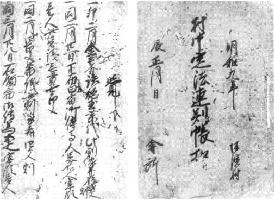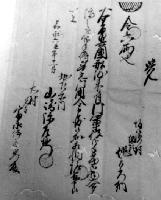Takahashi Family Documents
Update date: June 27, 2017

"Travel bill accompanying bathing in Izu"
At the Takahashi family home in Sakahama, Ancient documents The museum has 364 documents. The contents of the documents are about Sakahama Village in the Edo period. Land survey book , Tax The collection mainly consists of documents related to the construction of the village and water supply, and contains materials that allow visitors to learn about the state of Sakahama village at that time and the lives of the farmers who lived there. Kyoho They span a period of 153 years, from 1717 to 1870. We will introduce some of the most important basic documents among the precious early modern documents. (Note that in addition to the early modern documents introduced here, the Takahashi family also preserves modern documents from the Meiji period onwards.)
Yamakata Tax payment bill (Takahashi Family Documents 4)
Tax payment bill That is, when the annual tax was paid, Headman This is the most visible document in the Takahashi family documents, with 220 items in total, making up more than half of the entire Takahashi family documents. Tax payment bill It is the oldest document in the Enkyo It was created in December 1746 (the 3rd year of the Meiji Restoration) in Sakahama Village. New Field Development This is material that may be related to.
Muranaka Judgment Record (Takahashi Family Documents 54)
This document is generally referred to as " Village Registration Book " This is a document called "In the villages of the Edo period, Village official The village was run by the village manager, and the costs of running the village were borne by all the villagers. Village Needs " and the ledger that records the expenses and the percentage of the burden is called " Village Registration Book " This document is, Meiwa This document was created in January 1772, and gives concrete information about how the village of Sakahama was run at the time and the expenses the village bore. Village Registration Book of Ancient documents There is only one copy of this document in Yanokuchi Village, making it a valuable resource in that respect as well.
Construction request for Donomae Waterworks (Takahashi Family Documents 120)
This material was found on the Misawa River. Donomae Weir This document was issued when the cost of repairing the building (located east of the current Wakabadai Station on the Keio Line) that had been damaged by heavy rain and wind was received from the feudal lord. Weir Restorations such as these were sometimes carried out at their own expense, and sometimes, as in the case of this document, were carried out with assistance from the feudal lord. One of the characteristics of the Takahashi family documents is that they contain all the documents related to irrigation. Kansei era This document was created in August 1791.
Regarding the arrival of foreign ships Official money receipt document (Takahashi Family Documents 304)
Kaei In June 1853, Perry ordered the dispatch of four warships. Ship Led by Off the coast of Uraga In response to this commotion, the surrounding villages were flooded with people, horses, and Provisions The role of Imposition This document is for those who served in the military for defense. Land steward In order to achieve this, Village When collected from Land steward of Invoice In this way, Perry's arrival also affected the villages of Inagi.
Going to Izu for a bath Traffic bill (Takahashi Family Documents 291)
This document is Traffic bill This is a document about going to a hot spring in Izu to recuperate from an illness. parishioner Prove that you are a member of the Hakone Checkpoint In addition, " Traffic ticket " and provided a guarantee of identity. Kaei The document was created in 1848, and it appears that in the late Edo period, it was common for people in the Tama region to travel to hot spring resorts such as Izu and Hakone for medical treatment.
References: "Inagi City's Historical Documents (2)", "Inagi City History Volume", "Inagi City History Materials Volume 2"

"Yamakata Nengu Sumai Koden"

"Muranaka Johoren Judgment Copy"

"Donomae Irrigation Weir Construction Contract"

"Certificate of Receipt of Money for the Arrival of Foreign Ships"












